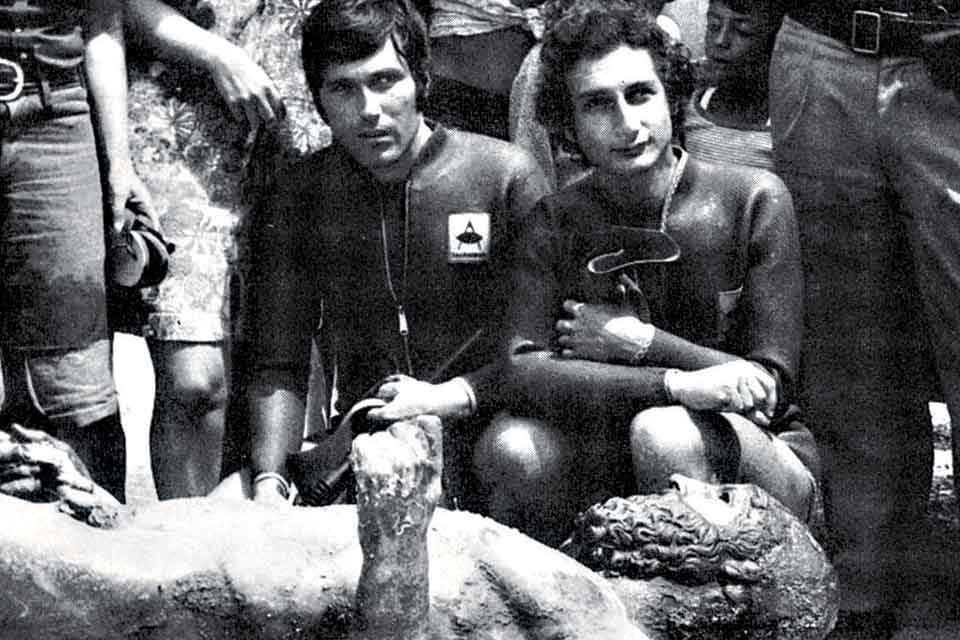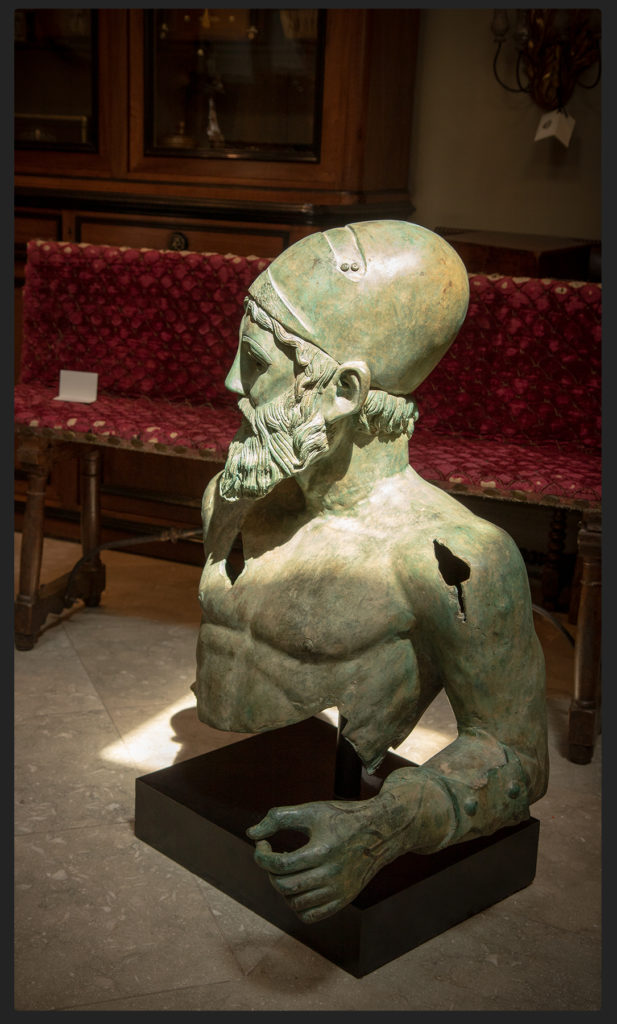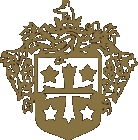
On August 16, 1972 Roman diver, Stefano Mariottini, made a “macabre” discovery. He was diving at a depth of 8 meters in the waters of Marina di Riace (Reggio Calabria), when he noticed a hand sticking out of the sandy bottom. He began digging in the murky sea floor until it revealed at first a face and then a full body. Indeed, there were two bodies; one lying on his back another lying on it’s side. These are what are now known as the Riace Bronzes. Both statues are almost two meters in height.
In the following days municipal divers tied ropes to balloons that were then filled with air lifting the bronze statues to the surface. Statue B was recovered on August 21st, while Statue A was retrieved the next day (It had previously fallen back to the bottom once before being brought safely to the beach). 1 2 3
The Riace Warriors (also referred to as the Riace bronzes or Bronzi di Riace) are two life-size Greek bronze statues of naked, bearded warriors. The statues are currently housed in the Museo Nazionale della Magna Grecia in the Italian city of Reggio Calabria. The statues are commonly referred to as “Statue A” and “Statue B” and were originally cast using the lost-wax technique 4.
These two warriors are an example of the severe style. The Severe or Early Classical style describes the trends in Greek sculpture between c. 490 and 450 B.C.E. Artistically this stylistic phase represents a transition from the rather austere and static Archaic style of the sixth century B.C.E. to the more idealized Classical style. The Severe style is marked by an increased interest in the use of bronze as a medium as well as an increase in the characterization of the sculpture, among other features. 5
The two statues are thought to represent Tydeus (Statue A) and Amphiaraus (Statue B), two warriors from Aeschylus‘ tragic play, Seven Against Thebes (about Polynices after the fall of his father, King Oedipus) 6 and may have been part of a monumental sculptural composition. The statues have lead dowels installed in their feet, indicating that they were originally mounted on a base and installed as part of some sculptural group. 7

Currently, we have an imposing and detailed cast bronze torso and head modeled after the Riace Warriors, Warrior B. on display in our gallery at 1700 16th Street in San Francisco 8 ^jh
Further readings and sources:
- Excerpt from Radici, Chi Sono? Da Dove Vengono? Chi Fu L’Autore E Perché Sono Finiti In Fondo Al Mare? Il Mistero Dei Bronzi Di Riace È Aperto., Jul 2016. https://www.radici-press.net/chi-sono-questi-due/ ↩
- Vanity Fair Italia Bronze Statues: who stole the third man? As promised by Vanity Fair, here are the documents and photos, discovered by Professor Giuseppe Braghò, which demonstrate the theft of the “kits” – shield, spears and helmets – of the two most famous Greek statues in the world. And also the existence of their “brother” https://www.vanityfair.it/news/italia/2012/08/16/bronzi-riace-40-anni-dopo-terzo-bronzo-rubato-furti ↩
- Strettoweb, Reggio Calabria, today the 45th anniversary of the discovery of the Riace Bronzes: an exciting story, “16 agosto 1972: 45 anni fa Stefano Mariottini ritrovava i Bronzi di Riace nei fondali del reggino Reggio Calabria, oggi il 45esimo anniversario del ritrovamento dei Bronzi di Riace: una storia emozionante”, August 2017, http://www.strettoweb.com/foto/2017/08/16-agosto-1972-45-anni-fa-stefano-mariottini-ritrovava-i-bronzi-di-riace-nei-fondali-del-reggino-foto/448020/ ↩
- Lost-wax casting, Wikipedia, https://en.wikipedia.org/wiki/Lost-wax_casting ↩
- Riace Warriors, Catherine E. Olson, Furman University, Scholar Exchange, https://scholarexchange.furman.edu/art231/40/ ↩
- Seven Against Thebes, Wikipedia, https://en.wikipedia.org/wiki/Seven_Against_Thebes ↩
- Excerpt from an Essay by Dr. Jeffrey A. Becker, Khan Academy https://www.khanacademy.org/humanities/ancient-art-civilizations/greek-art/early-classical/a/riace-warriors ↩
- Large Scale Cast Bronze Grecian Torso; modeled after the Riace Warriors (b), 20th century at Garden Court Antiques, https://www.gardencourtantiques.com/shop/large-scale-cast-bronze-grecian-torso/ ↩
